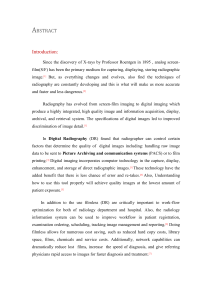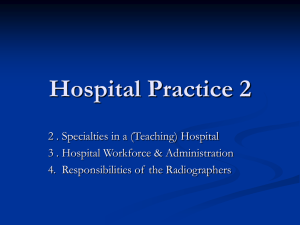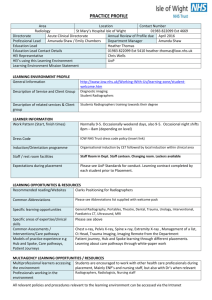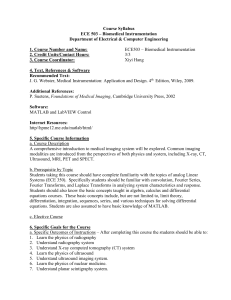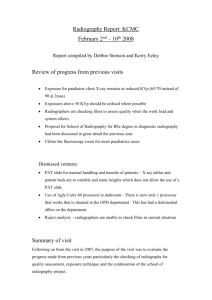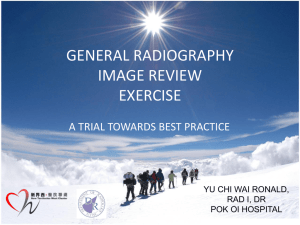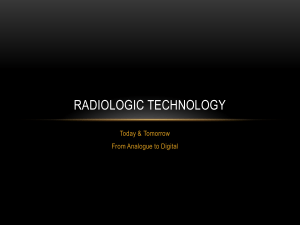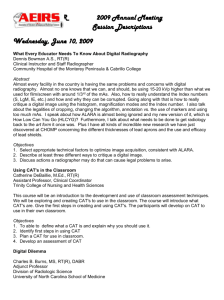Professional Issues lecture
advertisement
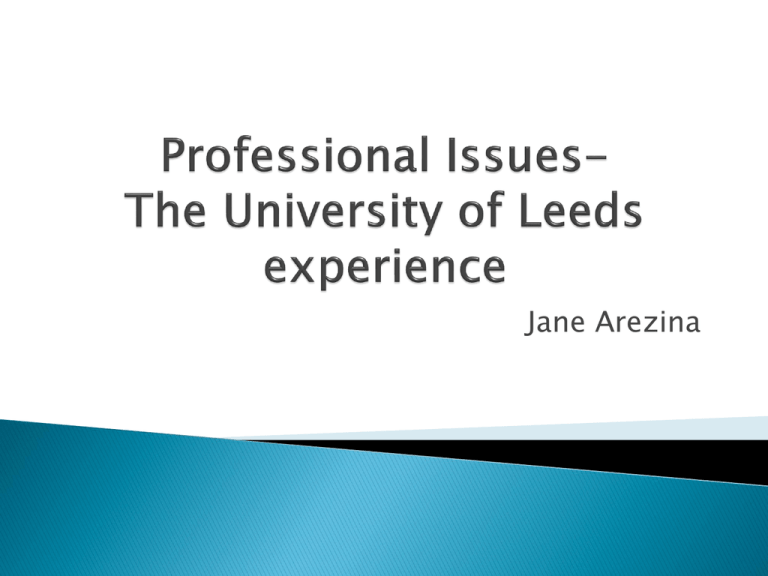
Jane Arezina The module aims to enable the practitioner to examine and develop their practice in relation to local and profession specific standards of diagnostic imaging Main theme are:◦ Image interpretation and reporting ◦ Communication ◦ Ethics and Law Programme is not specific to Medical Ultrasound Formed by the merger of the Medical Ultrasound and Breast Imaging programmes All students take Professional Issues in Diagnostic Imaging as a compulsory module, no matter which programme (PGC; PGD or MSc) and regardless of speciality (e.g. Breast Imaging or Medical Ultrasound) From a variety of professional backgrounds. Cohorts have included:◦ Radiographers ◦ Sonographers ◦ Medics Obstetricians Vascular surgeons A&E consultants ◦ Nurses ◦ Midwives ◦ Physiotherapists The principal aim of the module is to provide a structure to enable students to bring together self-knowledge, expertise at work and formal knowledge in order to foster and develop the highest standards in imaging practice The students critically reflect on their own practicerelated knowledge and enhance skills for advancing/extending professional practice Students need to consider the issues in relation to their specific clinical situation and profession specific content required by professional bodies (CASE or CoR). The students examine and evaluate different theoretical and analytic perspectives using critical reflection on their own practice-related knowledge. Student are encouraged and expected to contribute their own perspectives and examples from practice. Seminars and workshops are the main teaching methods used in this module with some content based lectures. The seminars and workshops are structured to facilitate discussion around the topic. Pre-reading is provided so that students come prepared for discussion and debate (some topics also require students to undertake tasks and bring these to the session). The focus is practice related and students will be asked to contribute examples from their practice to illustrate their arguments Module commences in semester 1 and is assessed in semester 2b to enable students’ theoretical knowledge and understanding to ‘grow’ in line with practice-based professional development Students are required to submit a 3,000 word portfolio relating to their own professional practice and issues in:◦ Image interpretation and reporting ◦ Communication ◦ Ethics and Law The portfolio enables the student to demonstrate a comprehensive understanding of theories and principles of professional issues in professional practice along with critical evaluation of its implementation in the work place. All imaging students are taught together to enable interprofessional interaction and collaboration Students have a set of ‘task’ to prepare and bring to sessions for discussion Portfolio includes 3 reflective academic pieces of work related to the main themes In addition, they must include the tasks and any supporting material as appendices Have to do a lot of work themselves and often find the module ‘difficult’, ‘not related to my own practice’ Don’t like interprofesional nature of teaching and learning-want more profession/modality specific content Portfolio is seen as a major task-even though have 9 months to complete it Don’t like all the tasks and sometimes can’t see relevance to learning ‘how to do a scan’ Many students produced fabulous portfolios that clearly demonstrate their professional development Encourages students to explore why they are doing things a certain way-evidence based practice, self-development and critical appraisal are key features Use of reflection enables some students to have ‘light-bulb’ moments that alter the way they practice Some students have used the knowledge gained to make changes in clinical practice Many positive comments in the portfolio re: how they felt about the module at the beginning and how they now realise how fundamental these topics are to practice The module is utilised to introduce generic content e.g. Reporting or communication that is developed further in specific modules Encourages students to self-develop through reflection and critical appraisal-students often find this challenging Encourages IPW and consideration the views of other professionals-also challenging Most students showed progression in their professional development and a clear understanding of the role the module will have in their future practice ALDERSON, C.J. and P., HOGG, 2003. Advanced Radiography Practice-the Legal Aspects. Radiography, (9) pp. 305-314 BEAUCHAMP, T., L., and J.F., CHILDRESS, 2001. Principles of Biomedical Ethics. 5th ed Oxford: OUP CHAMBERS, R., and G., WAKELY, 2000. Making Clinical Governance work for you. Radcliffe Medical Press DAWES, M., and P., DAVIES. 1999. Evidence Based Practice- A primer for Health Care Professionals. Edinburgh: Churchill Livingstone DIMOND, B., 2002. Legal Aspects of Radiography and Radiology. Oxford: Blackwell Science ELLIOT, V., et al, 2008. Research Utilisation in Sonography Practice: Attitudes and Barriers. Radiography,, pp. 1-9 HARDY, M., and B., SNAITH, 2006. Role Extension and Role Advancement-is there a difference? –A discussion paper. Radiography, 12, pp. 327-331 HARDY, M., and B., SNAITH, 2007. How to Achieve Advanced Practitioner Status–A discussion paper. Radiography, 13, pp. 142-146 KENNEDY, I., and A. GRUBB, 2000. Medical Law, Text and Materials. 3rd ed. London: Butterworth. MASON, J., K., and R., A., MCCALL-SMITH, 1999. Law and Medical Ethics. 5th ed. MC SHERRY, R., 2002. Clinical Governance: A guide to implementation for healthcare professionals . Oxford : Blackwell Science MORELL, C., and G., HARVEY, 1999. The Clinical Audit Handbook. London: Balliere Tindall MUIR-GRAY, J., A. 2001. Evidence Based Health Care. Edinburgh: Churchill Livingstone NIGHTINGALE, J. and P., HOGG, 2003. Clinical Practice at Advanced Level. An Introduction. Radiography 9 pp 77-83 NIGHTINGALE, J., 2008. Developing Protocols for Advanced and Consultant Practice. Radiography pp. 1-6 REIGELMAN, R., K. 1996. Studying a Study and Testing a Test: How to read the Health Sciences Literature . Lippincott - Raven SIMPSON, R. and R., BOR, 2001. ‘I’m not picking up a heart-beat’: Experiences of Sonographers giving bad news to women during ultrasound scans. British Journal of Medical Psychology 74 pp 255-272 SWAGE, T. 2000. Clinical Governance in Healthcare Practice. Butterworth: Heinemann THE COLLEGE OF RADIOGRAPHERS 2005. Research and the radiography Profession. A Strategy and Five Year Plan. The College of Radiographers; London THE ROYAL COLLEGE OF RADIOLOGISTS AND THE SOCIETY AND COLLEGE OF RADIOGRAPHERS, (2007). Team Working within Clinical Imaging. A contemporary View of Skill Mix. The Royal College of radiologists and the Society and College of Radiographers: London THE ROYAL COLLEGE OF RADIOLOGISTS, 2006. Standards for the Reporting and Interpretation of Imaging Investigations. The Royal College of Radiologists; London THE SOCIETY AND COLLEGE OF RADIOGRAPHERS 2005. Medical Image Interpretations and Clinical Reporting by Non-radiologists: The Role of the Radiographer . The College of Radiographers; London THE SOCIETY OF RADIOGRAPHERS, 2006. Statement on Ultrasound Referrals and Professional Indemnity Arrangements. The Society of Radiographers; London UKAS. 2001. Guidelines for professional working practice. UKAS. VINCENT, C., 2001. Clinical Risk Management – Enhancing Patient Safety. BMJ

